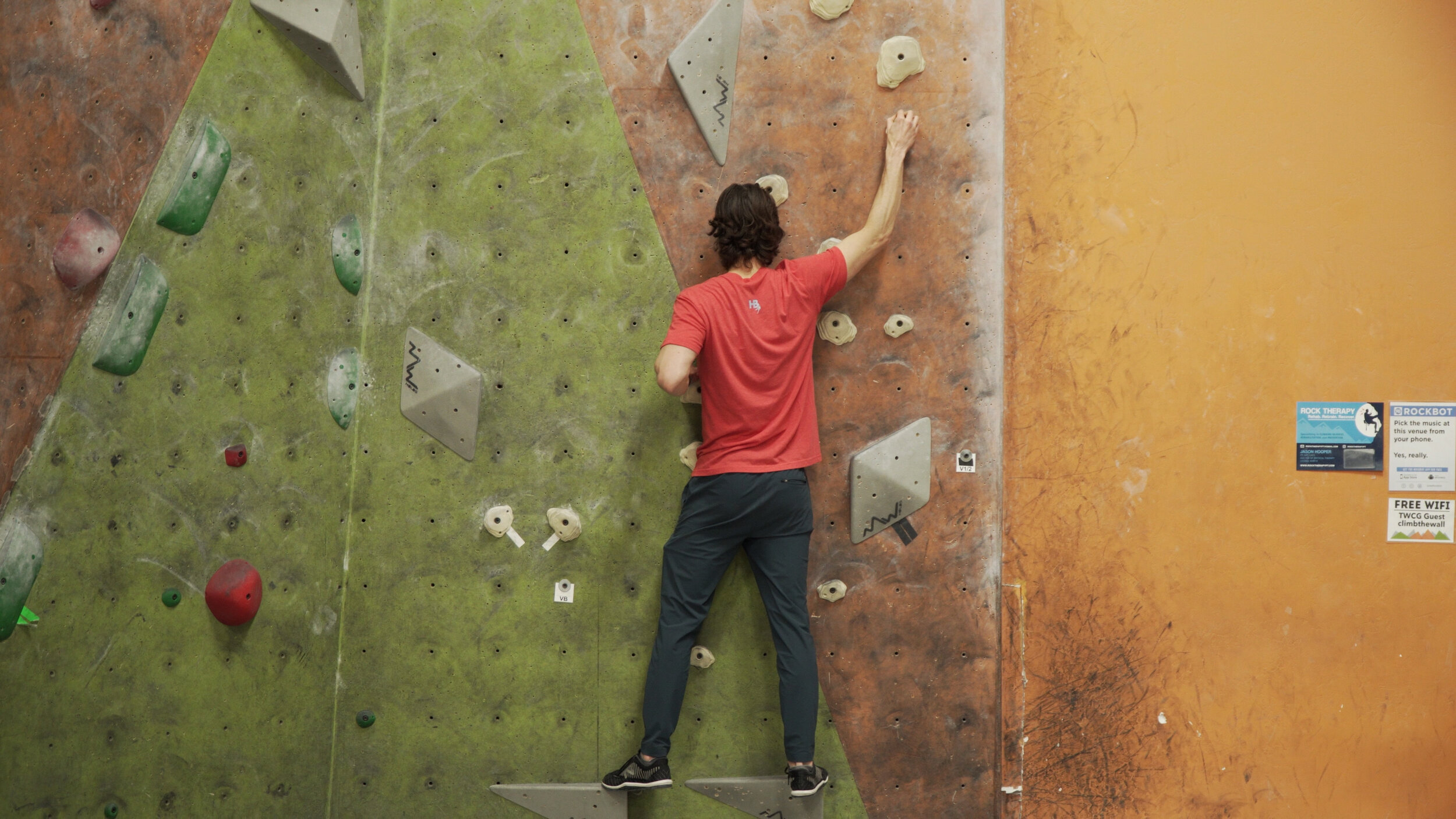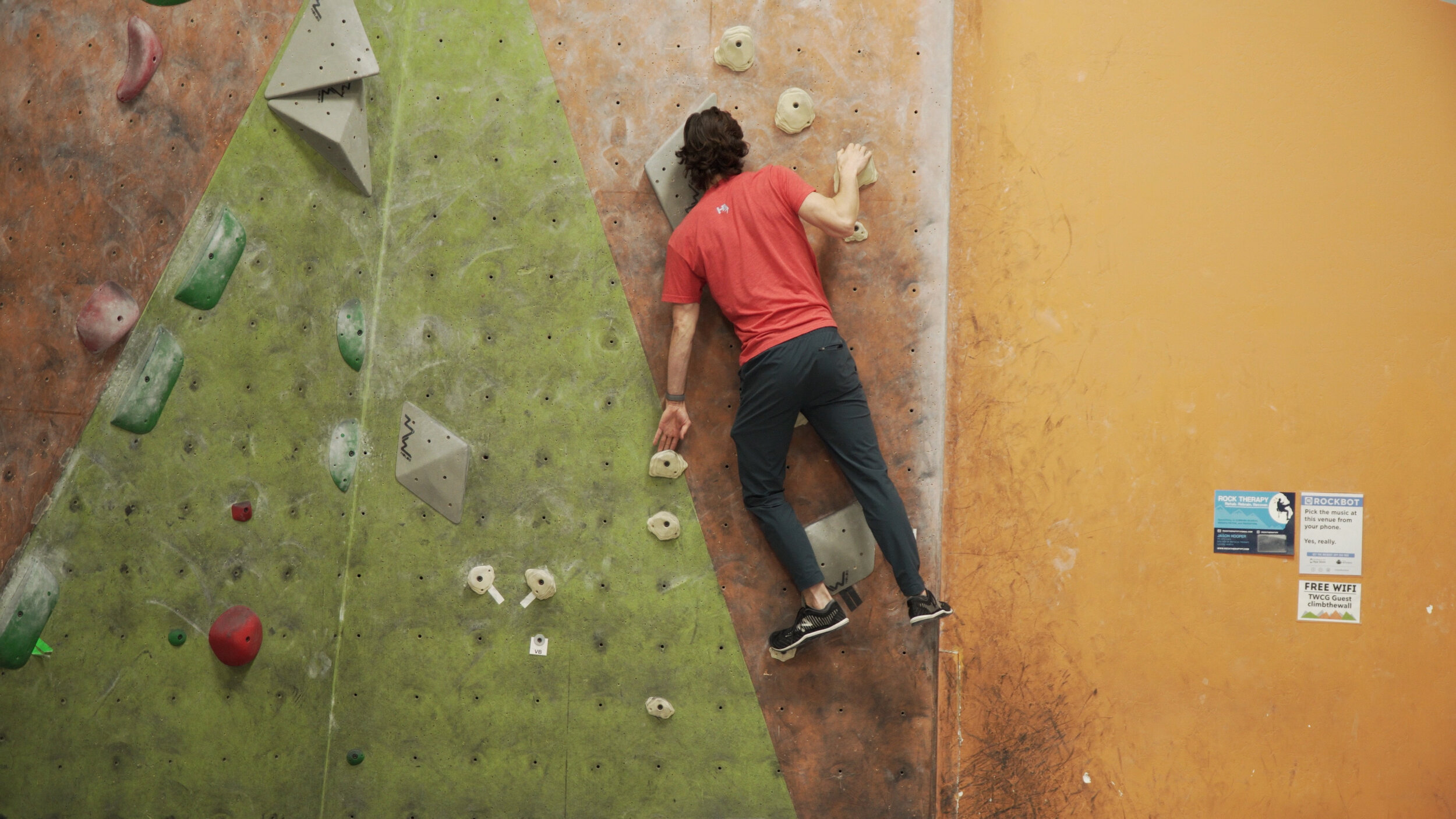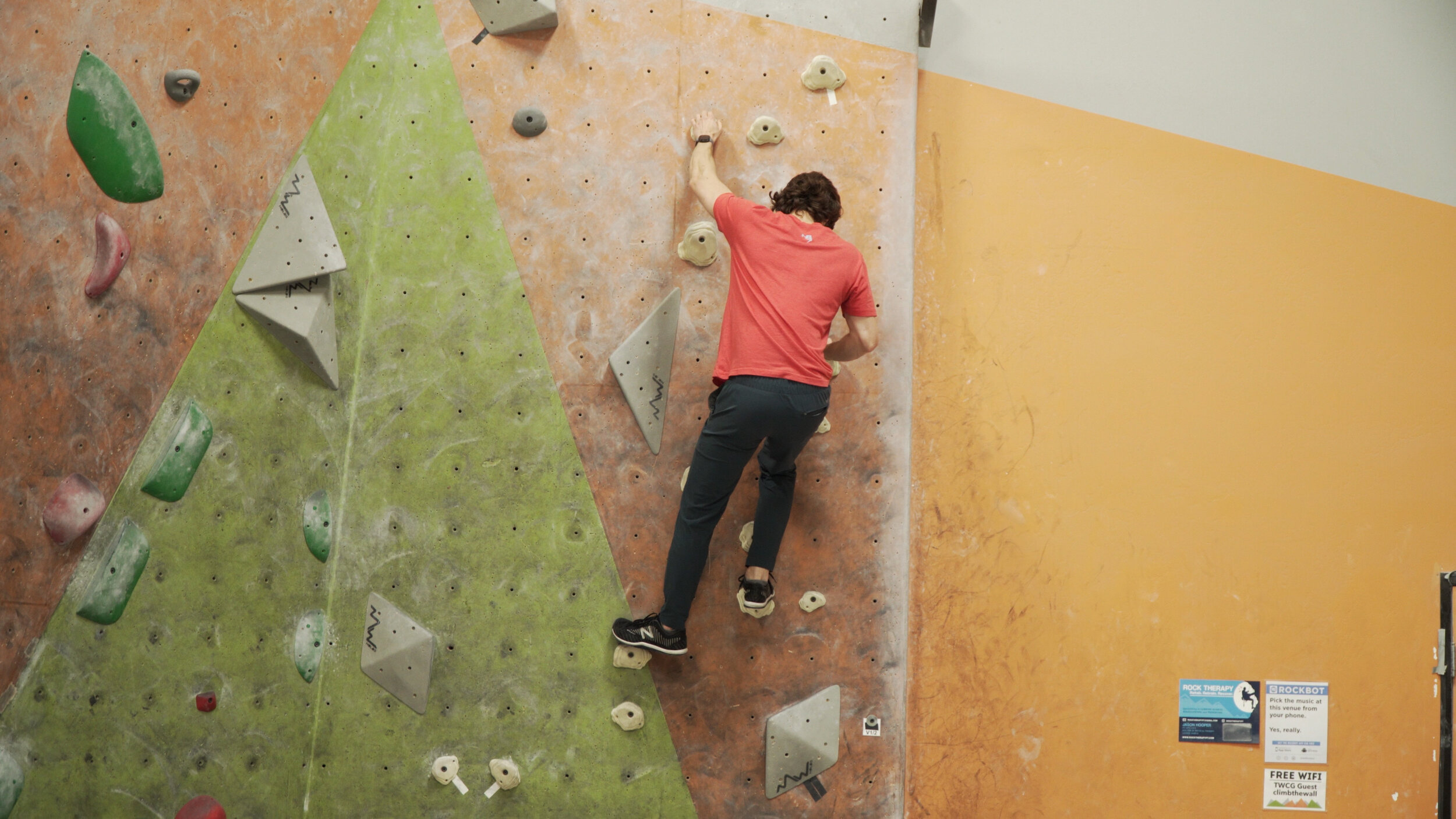Why Your Lower Traps are Key for Climbing Safely (and How to Train Them)
Hooper’s Beta Ep. 80
Introduction
I’ve said it once, I’ve said it twice, Heck, I’ve said it a bunch of times on the anatomy of the climb videos: “here’s a good reason to train your lower traps” and yet, we don’t have a video for you about the lower trap! Well not anymore! It’s time to get low, and trap ourselves.
In this video, we will cover the function of the lower trap from both a biomechanical and climbing perspective. We will also provide two basic tests you can do yourself to see if strengthening the lower traps is something you need to be concerned about in the first place, and then we’ll talk about how to properly train the lower trap on and off the wall. So let’s get to it!
ROLE OF THE LOWER TRAP IN CLIMBING
Essentially, the lower trap helps with…. Everything! It’s most important role is when the shoulder is overhead but it plays a role throughout our motions. It is helpful when pulling hard in the cave, or when reaching way above you for that next hold. It’s even helpful when dynoing for that glory jug. If you haven’t watched our “Anatomy of the Climb” series yet, check them out! You’ll notice the lower trap comes up as a topic of discussion in basically every video. To better understand how it specifically helps with our climbing, let’s check out it’s biomechanical function.
BIOMECHANICAL FUNCTION OF LOWER TRAP
The lower trapezius has a few important functions in our biomechanics.
The lower trapezius assists with upward rotation of the scapula. As we raise our arm up, the scapula has to move with it. The upper trapezius helps create the rotation we need so that the humerus and scapula maintain a good position with one another.
The lower trap is also a stabilizer for the shoulder during the initial elevation of the arm. When you first begin to lift your arm, the deltoids engage and create force. This force creates downward rotation of the scapula. The lower trapezius thus FIGHTS that downward rotation, countering it with a stabilizing upward rotational force. This is true for about the first 20-30 degrees of elevation of the arm during abduction (or when the arm moves out to the side).
I mentioned that the lower traps help with upward elevation of the scapula, but so does the serratus anterior muscle. The serratus anterior muscle, though, creates shoulder protraction. If this went unchecked, it would cause poor biomechanics aka it could set you up for an injury. The lower trapezius helps combat this protraction by retracting the shoulder. #balance
Finally, the lower traps have also been shown to be most active in the 90-180 degree range of motion of the shoulder. Since this is the most common position for our arms to be in while climbing, you can probably see for yourself why having strong lower traps is beneficial.
So all that anatomy stuff is great, but what actually happens to you as a climber if you have weak lower traps? Poor upward rotation, poor scapular retraction, and anterior tilting of the shoulder? Emphasize these results when the shoulder is at or above 90 degrees, with a structure that depends on the muscles and connective tissue for stability? This can lead to issues with rotator cuff pathologies, impingements, or as bad a labral tears or other issues. So, yeah, it can be important.
Disclaimer: not everyone with weak lower traps will suffer all of those things, they are just possibilities.
TESTING FOR LOWER TRAP WEAKNESS
In general, I think it’s a great idea for pretty much everyone to include some lower trap strengthening into their training program, but if you’d like a more definitive answer on whether or not you have weak lower traps, you’re in luck. I’ve got two different tests for you coming right up!
Test #1 - Manual Muscle Test

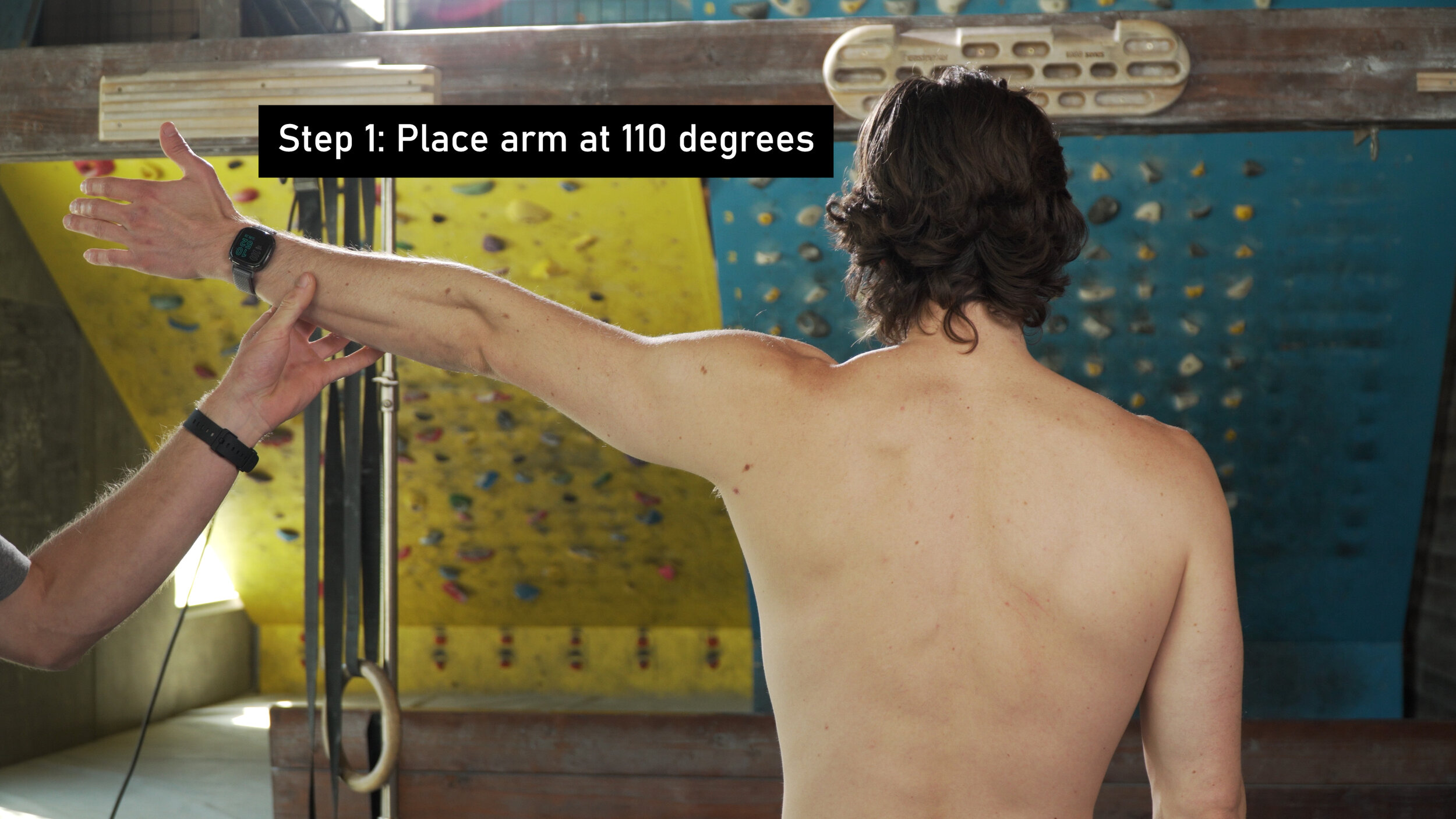
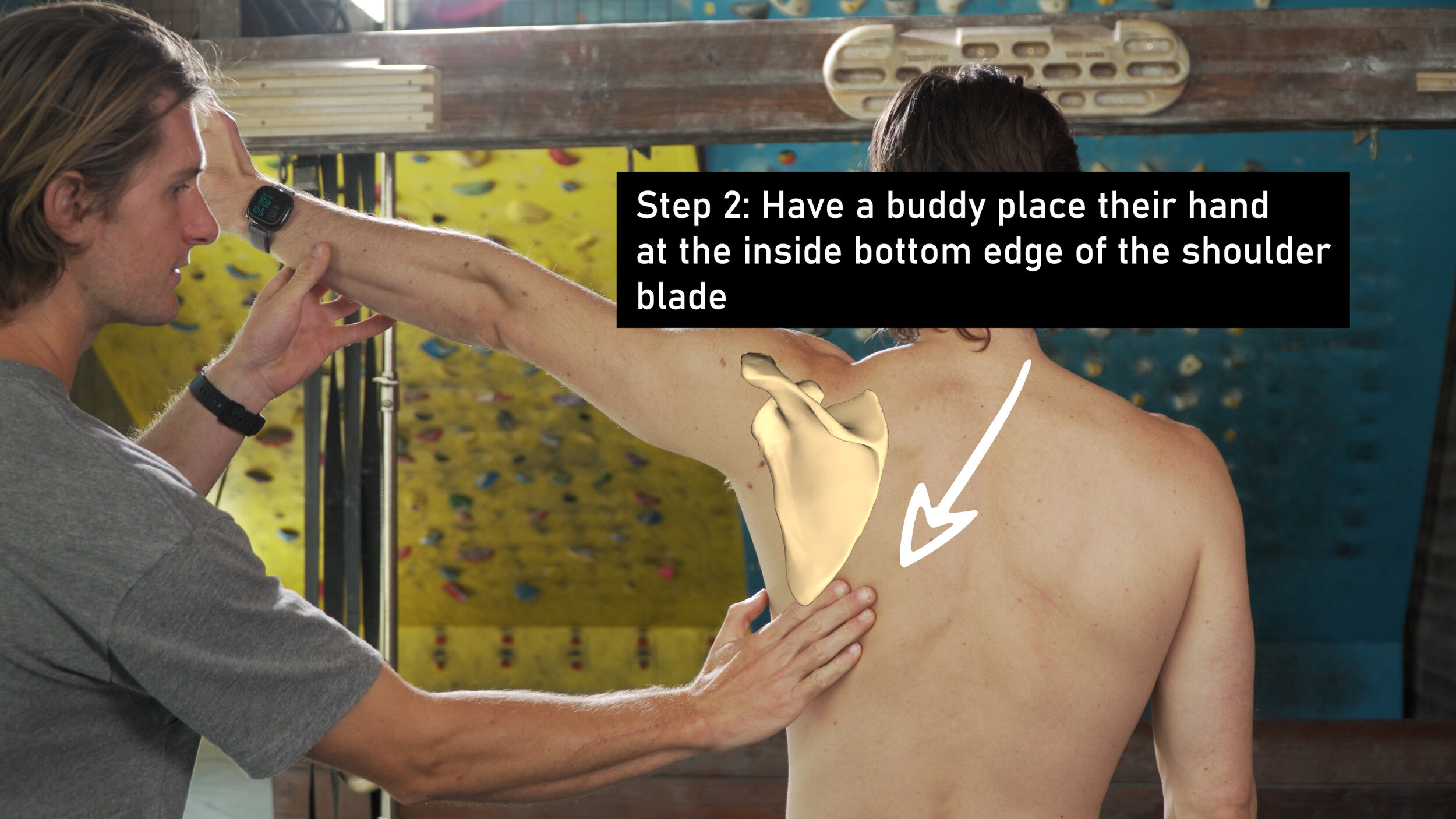

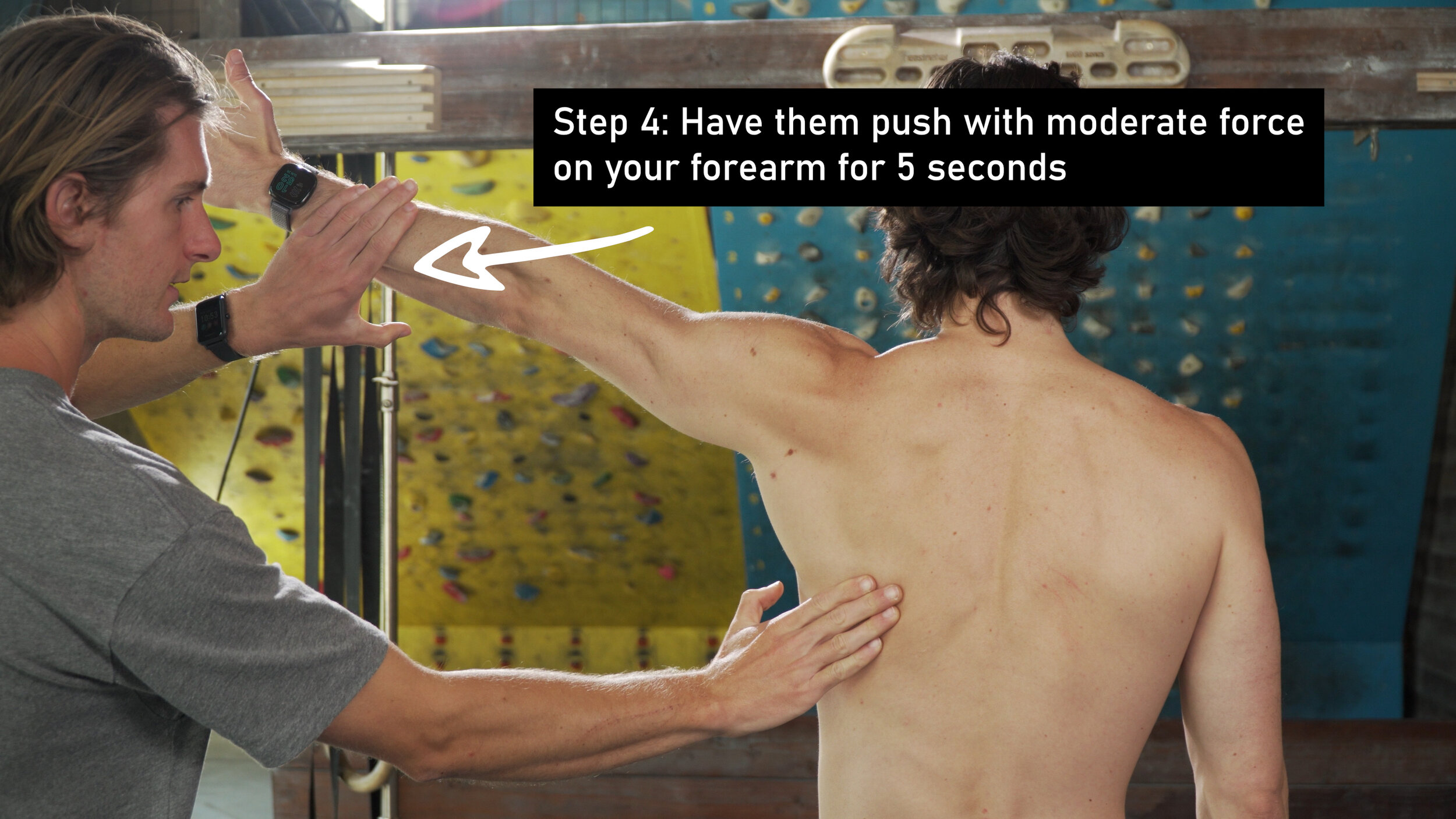
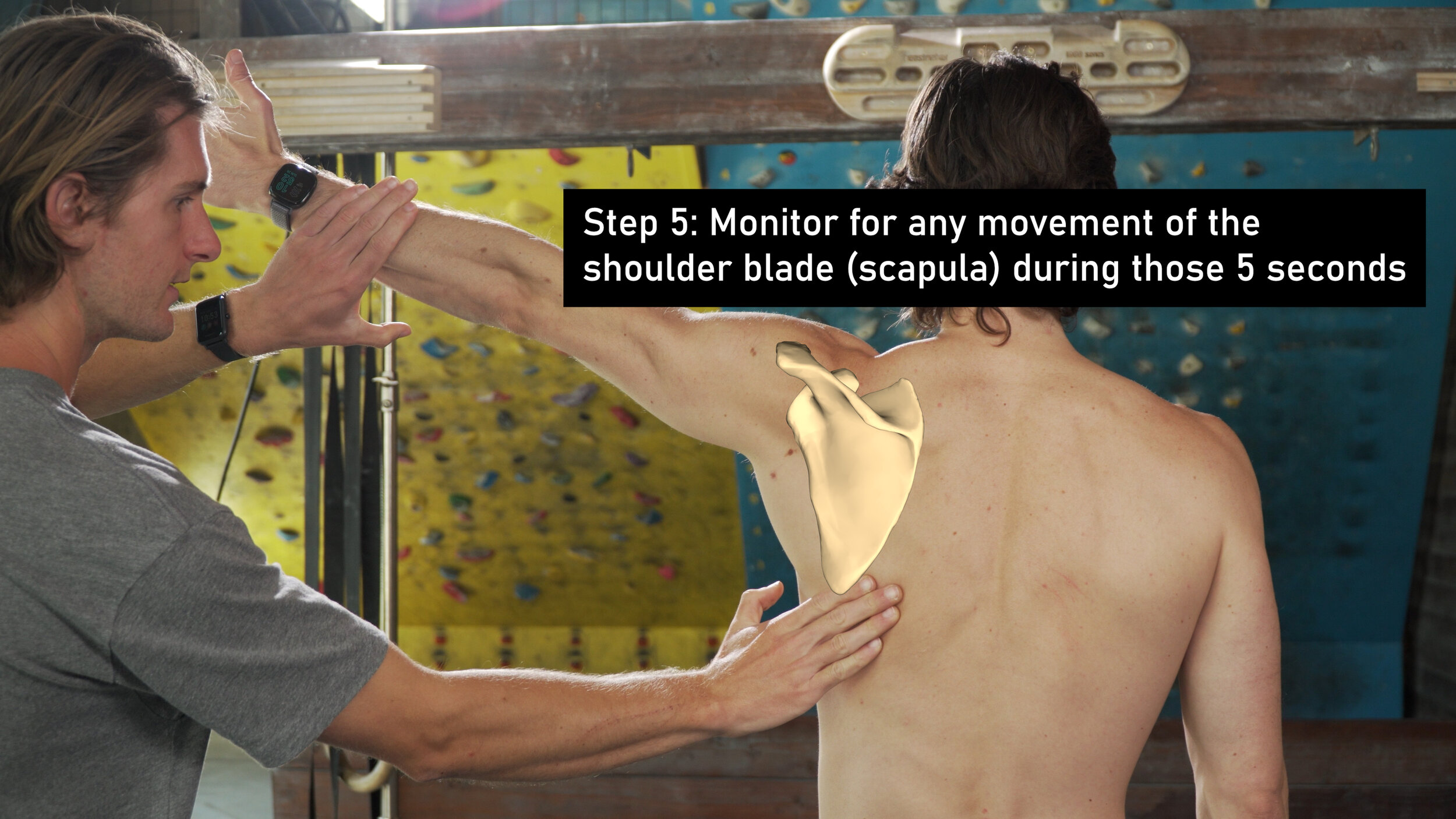
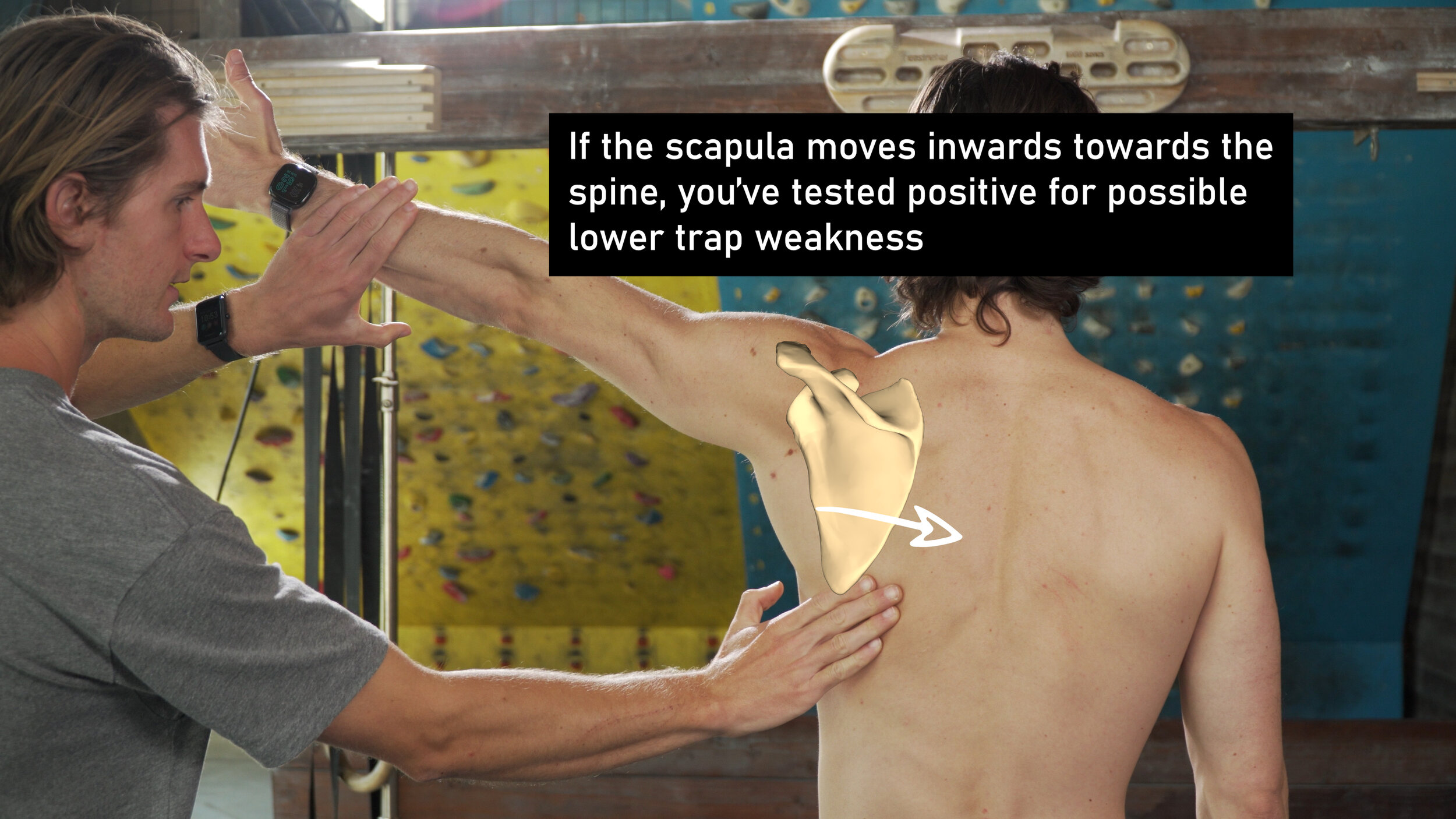
In an article titled “A new manual muscle test for assessing the entire trapezius muscle,” researchers found a new valid and reliable test for the lower trap that doesn’t require an expert to administer.
Here’s how you do it:
Place the test shoulder in 110 degrees of abduction.
Quick side note: you need the shoulder blade exposed for this so fellas, shirt off or tank top party. Ladies, buy that new Train. Climb. Send. Repeat - tank top and you’re guaranteed a good testing time!
The palm will face the ground
Have your buddy place one hand on the medial border of the scapula or shoulder blade at the bottom or inferior angle of the scapula. Next use the other hand to place pressure on the mid-forearm of the arm you’re testing.
Maintain this preposition for at least 5 seconds with moderate pressure.
While in this position, have your buddy monitor for any movement of the scapula where you just placed your hand. If it moves medially or in towards the spine, that would suggest that the trap was not holding it’s upwardly rotated position.
Now, there are sources of error in this. The harder you push on the forearm, the more likely you are to get a positive test. So only push with moderate pressure to produce a more accurate result.
Test #2: Wall Angel Test
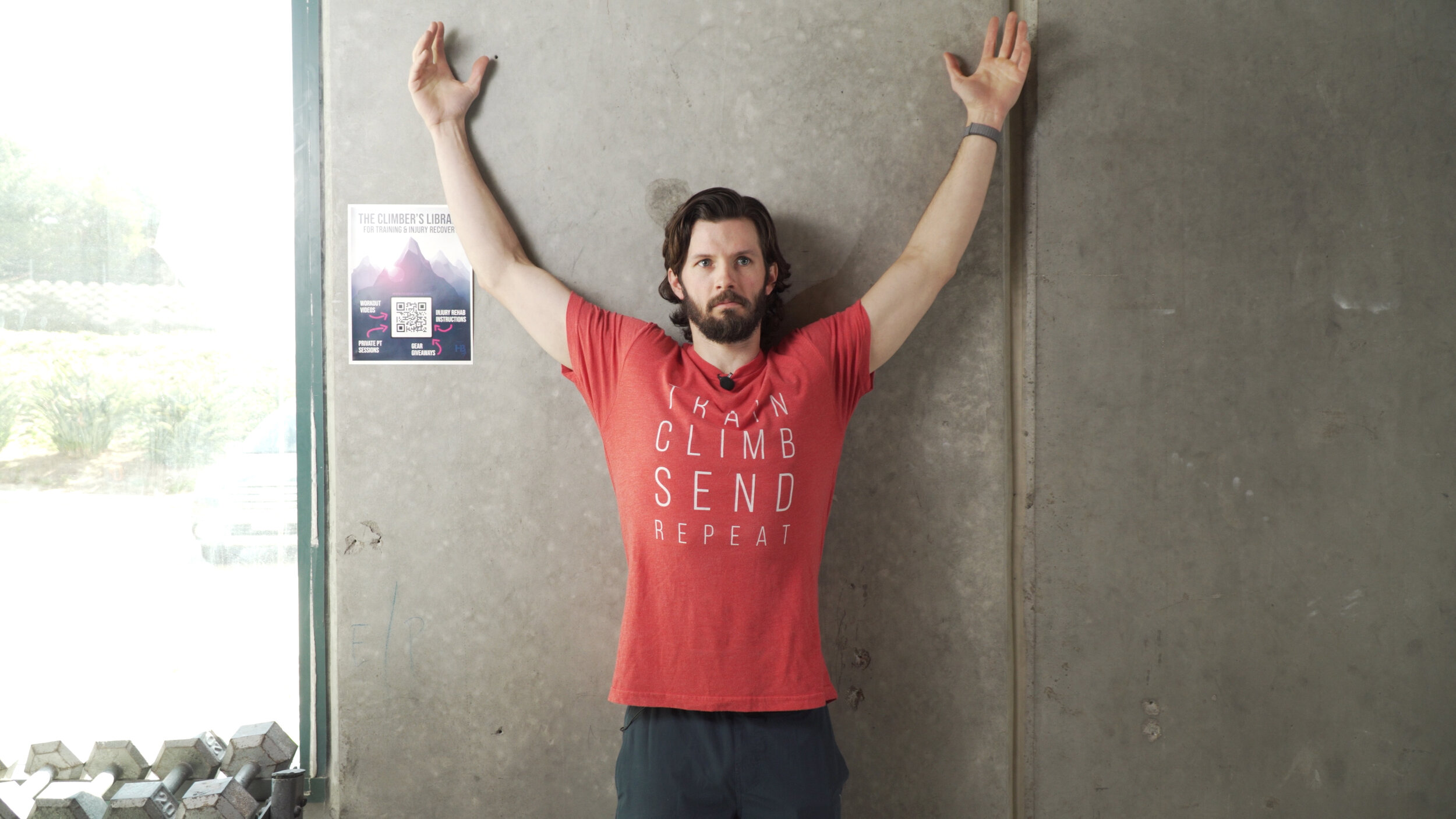
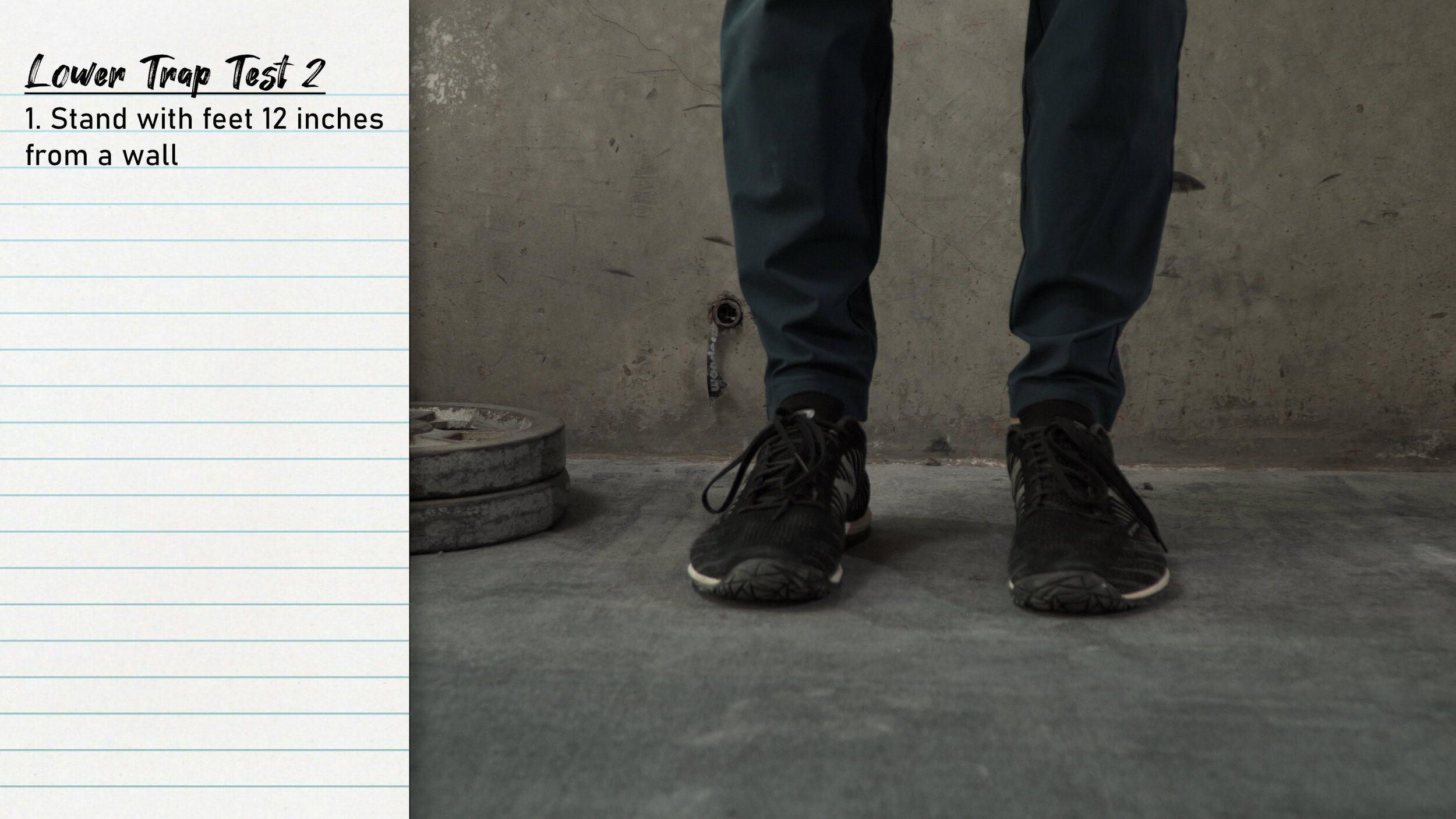
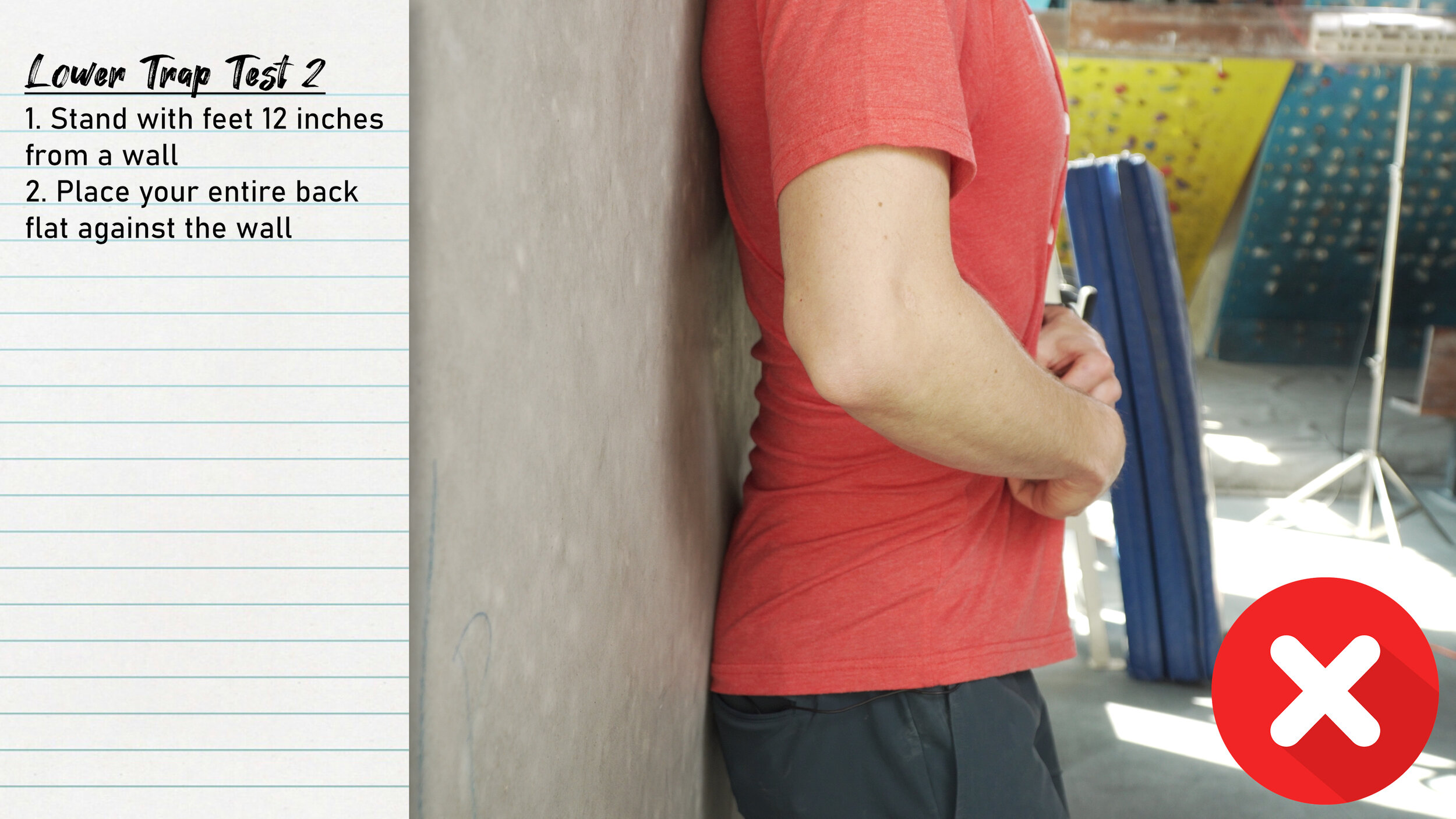
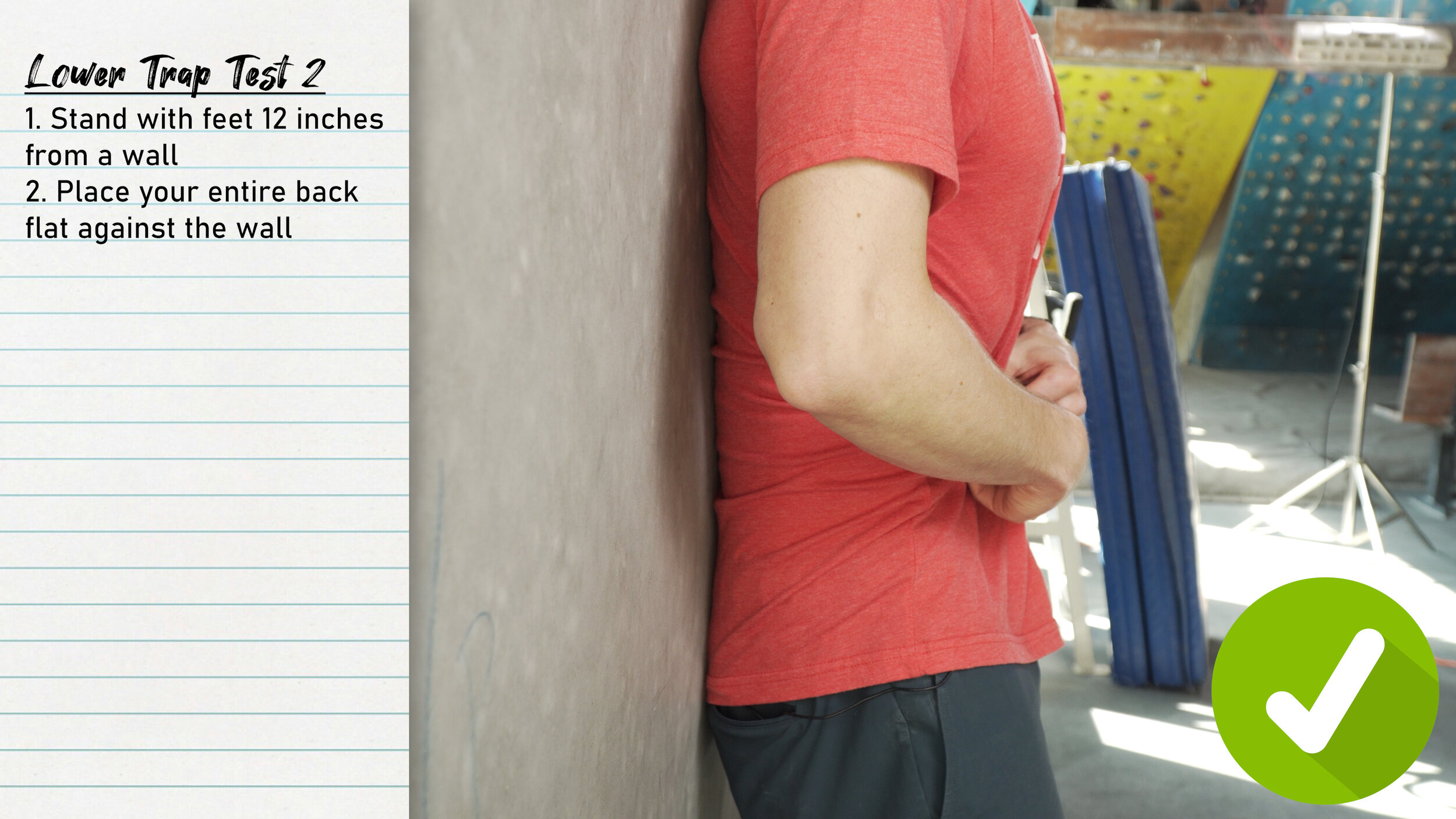
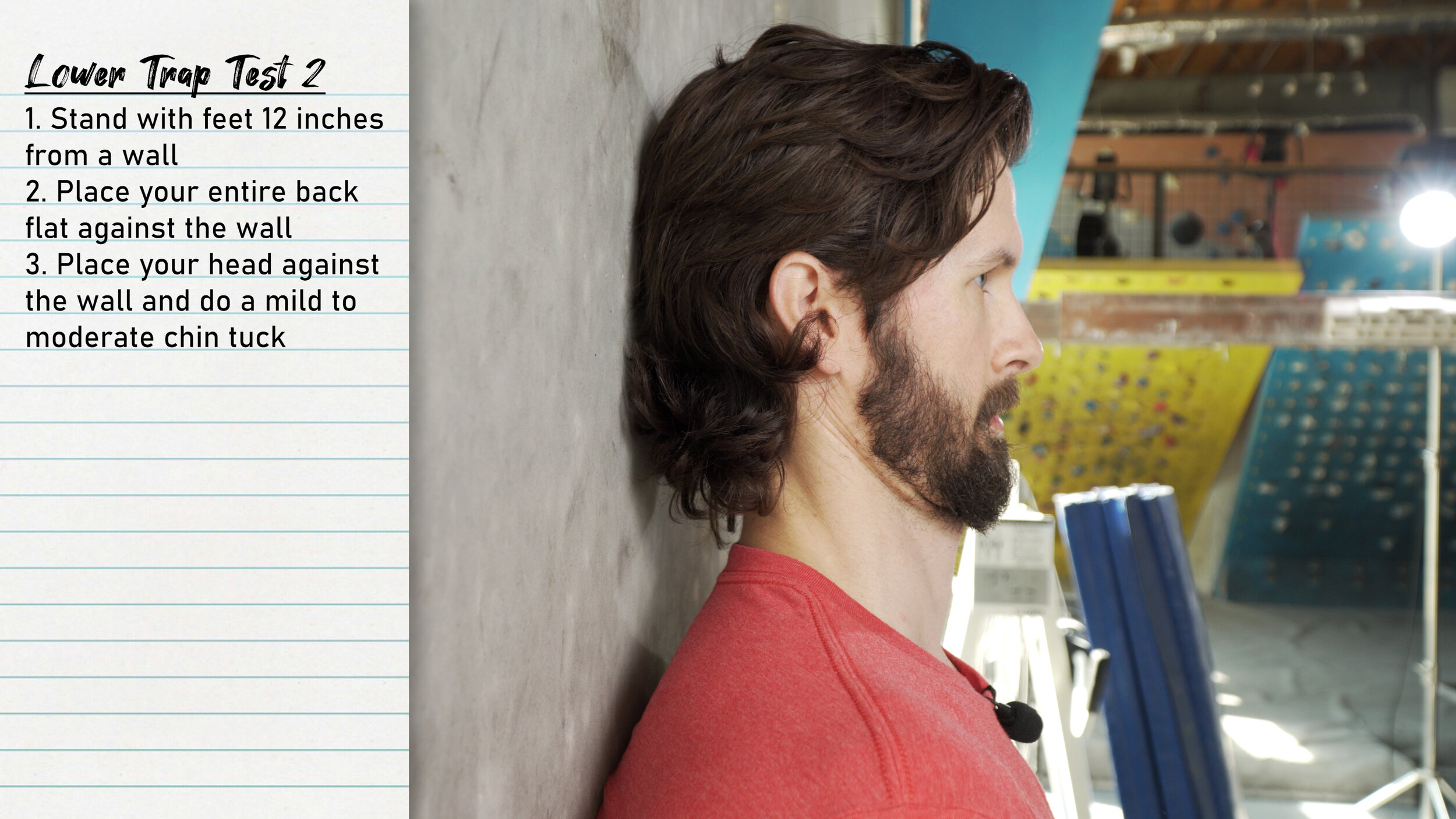
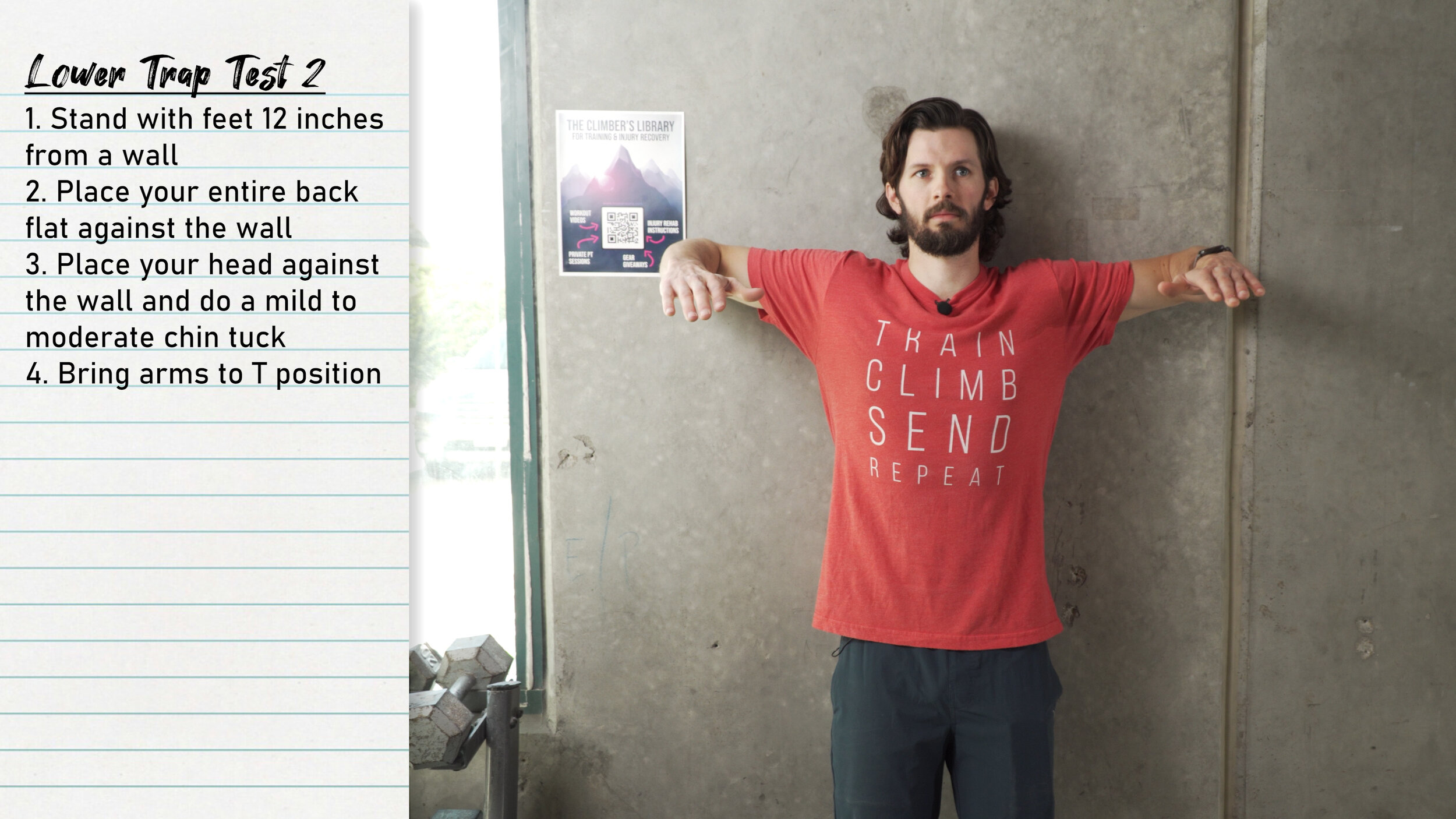
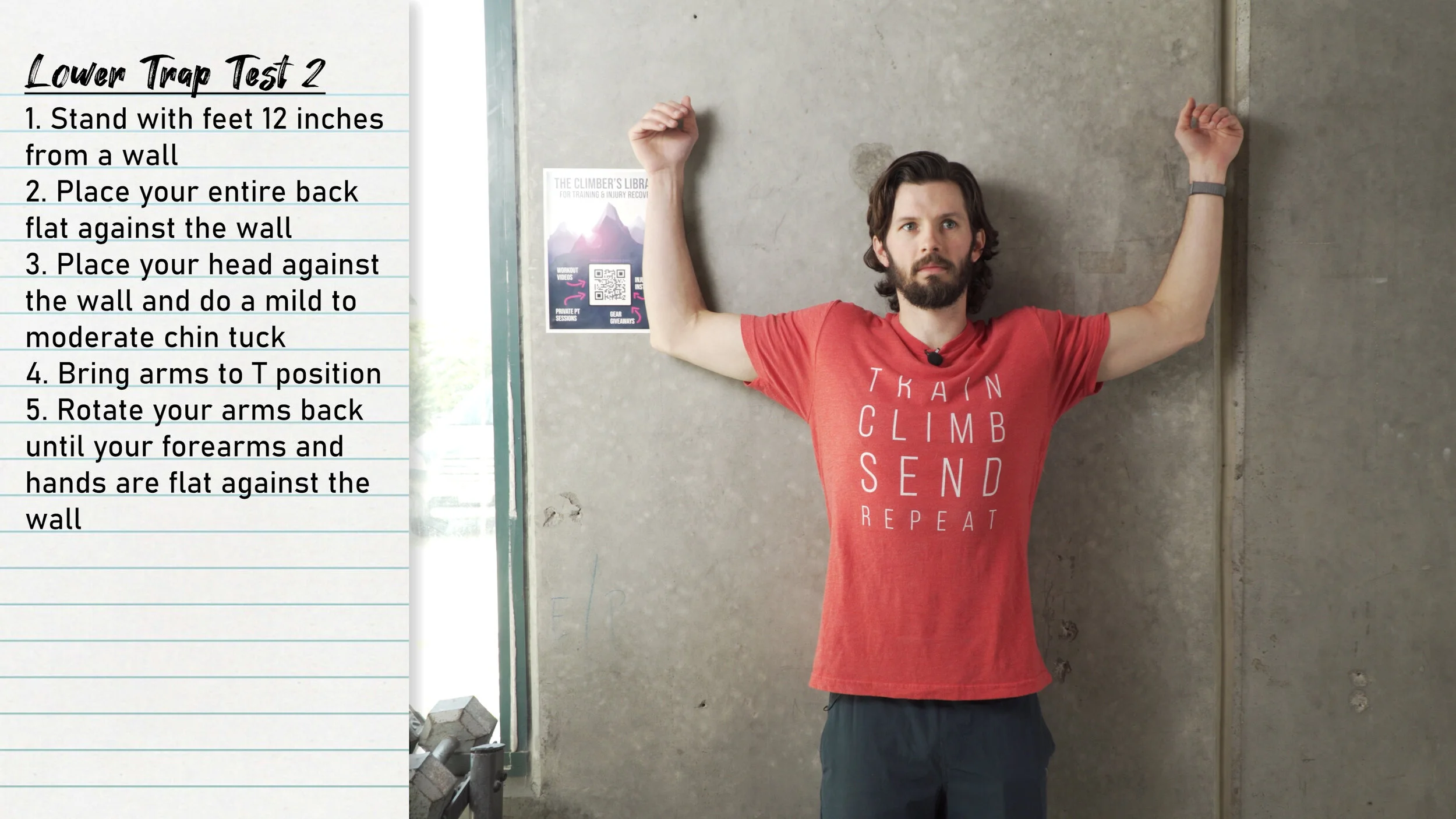
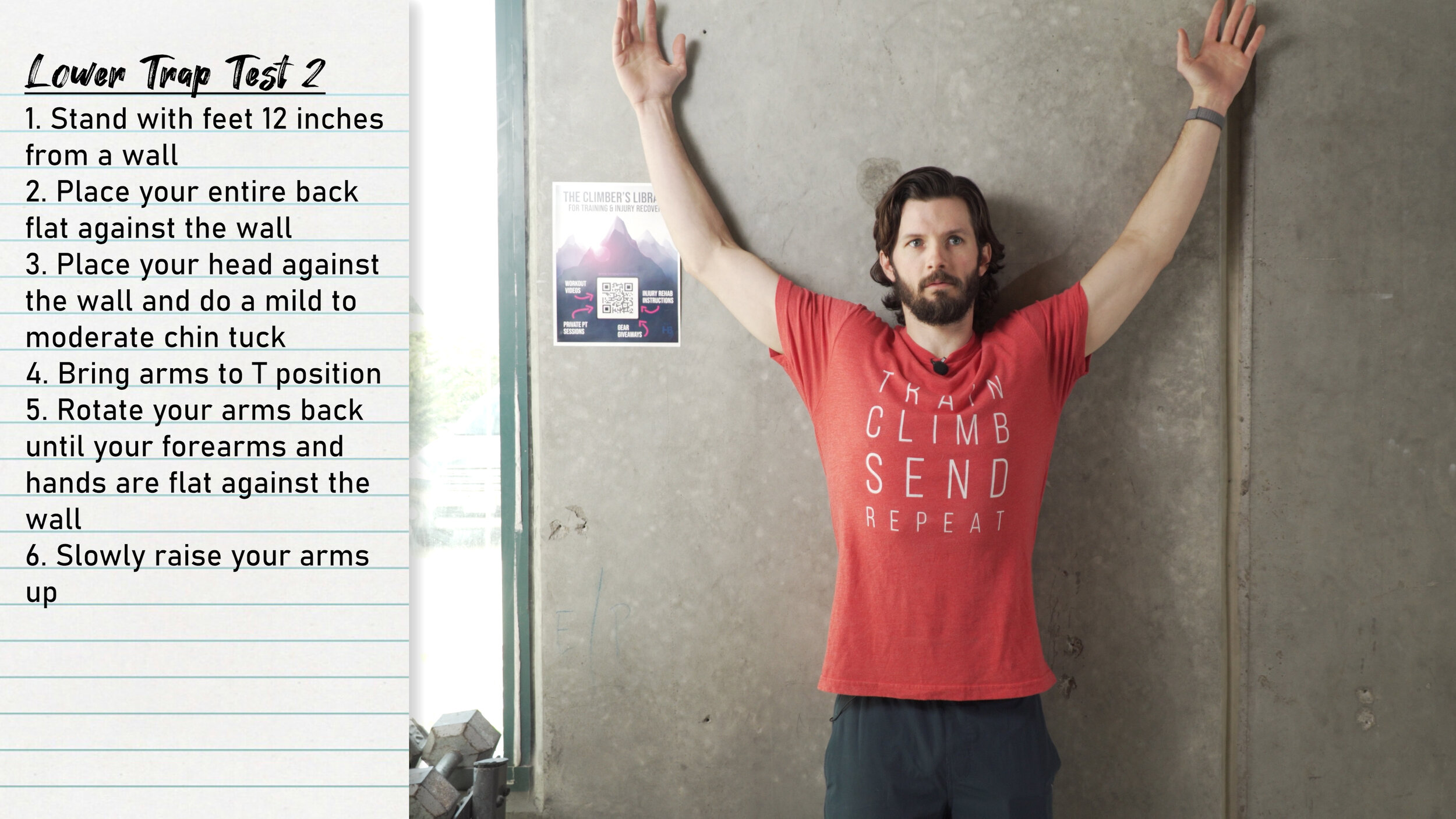
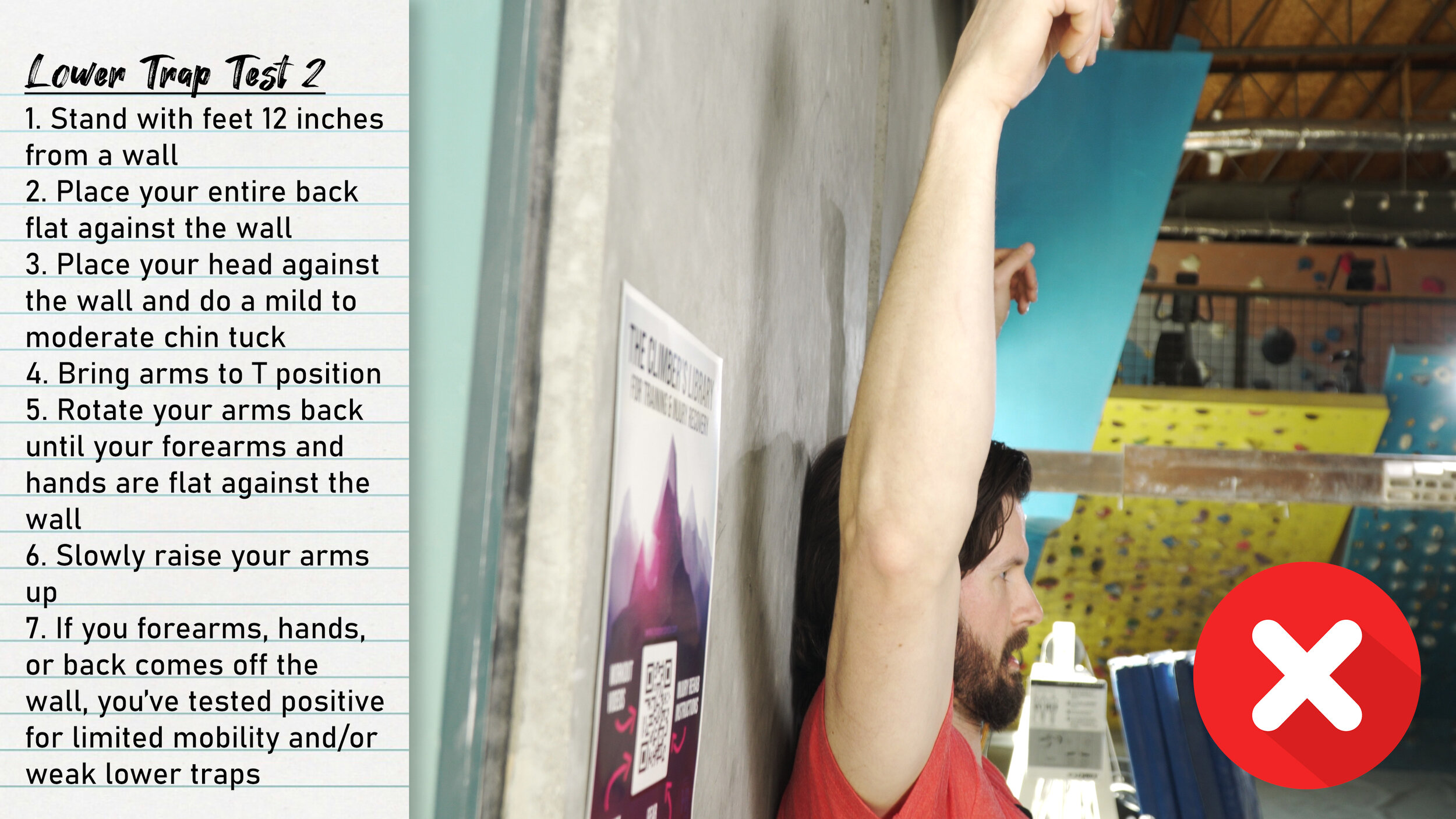

Now, for those of you who don’t have any friends, here’s a different test you can do.
Disclaimer here: the prior test is backed by science. This test on the other hand is simply a functional test that can help you lone wolf types.
One more note: men are more likely to struggle with this test compared to women because we typically have tighter chests and worse thoracic mobility.So, if you struggle with this test, it may be an indicator to work on mobility, external rotation and/or lower trap strength!
For this test you’ll perform a chin tuck with arm external rotation and lower trap activation.
Here’s how to do it:
Stand with feet approximately 12" from the wall.
Place your lower back flat on the wall and work the entire spine up to be flat.
Note: this is your first mobility check for the spine as well as your first check to see if you have good core and pelvic control! If you cannot get the spine flat, work on it.
Place your head against the wall and perform a mild to moderate chin tuck.
Next, bring arms to a T with elbows bent 90 degrees.
Rotate your shoulders and forearms backwards until your forearm and hands are against or near the wall.
While maintaining hands against the wall, slowly raise your hands straight up.
If your forearms and hands come off the wall, that is your end point for now and your sign that you may have a mobility or strength deficit.
After performing that test, what did you feel? If you simply felt tightness in your chest or thoracic spine, you may be getting a false positive. To avoid that, do some stretching and try the test again. However, if you determine that mobility is not your issue and you're still getting a positive test result (forearms and hands come off the wall), you may very well have a strength deficit in the lower traps.If so, you can even turn this into an exercise!
Now, climbing itself will help strengthen the lower traps. BUT, if you’re looking to step it up and really keep the shoulders healthy, or if you’ve found out you have weak ass lower traps, here are the best exercises to do!
Quick side note: We will be releasing another video that has even more great variations, so keep an eye out for that!
My Top 3 Recommendations to Include in Your Training
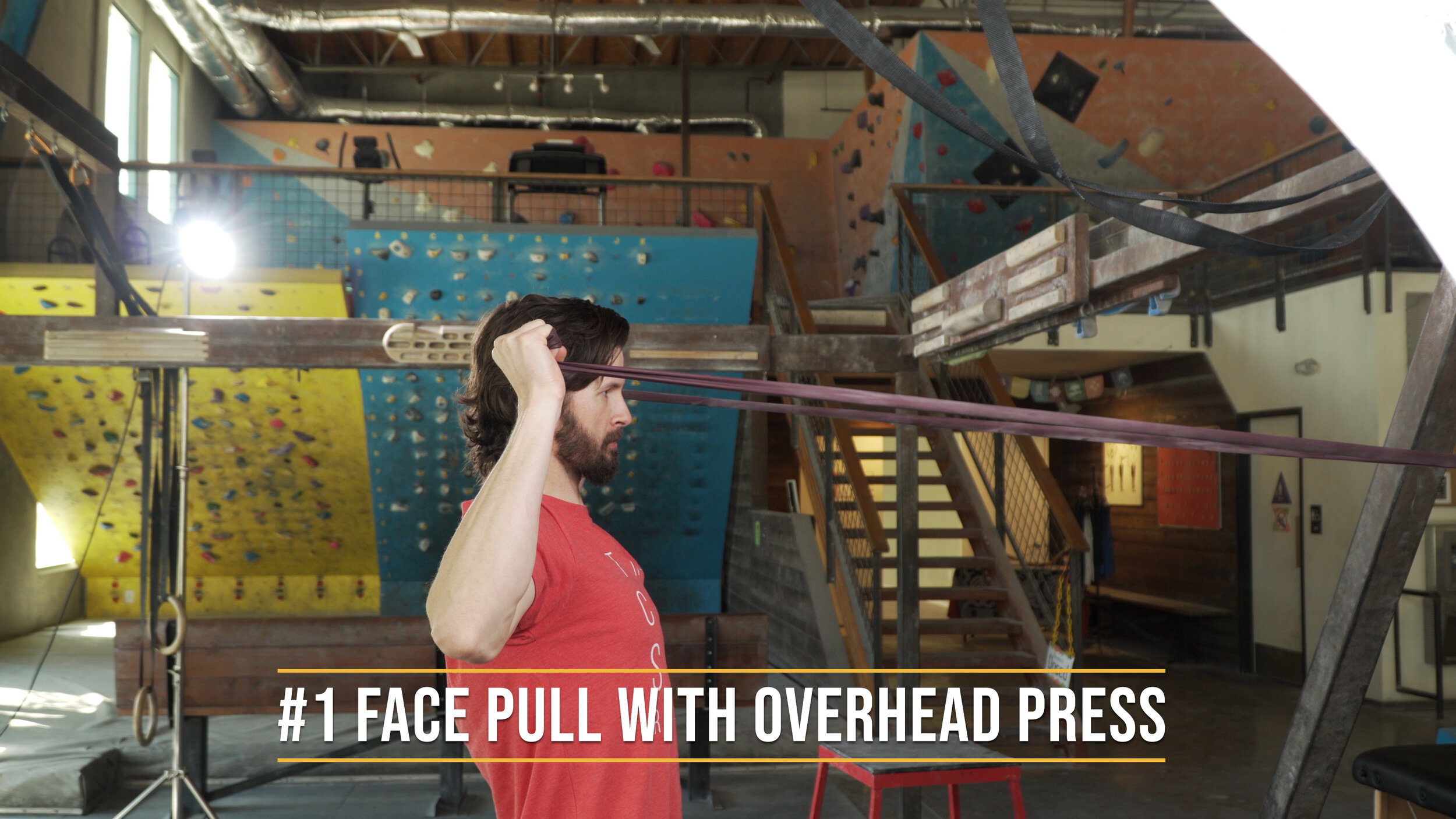
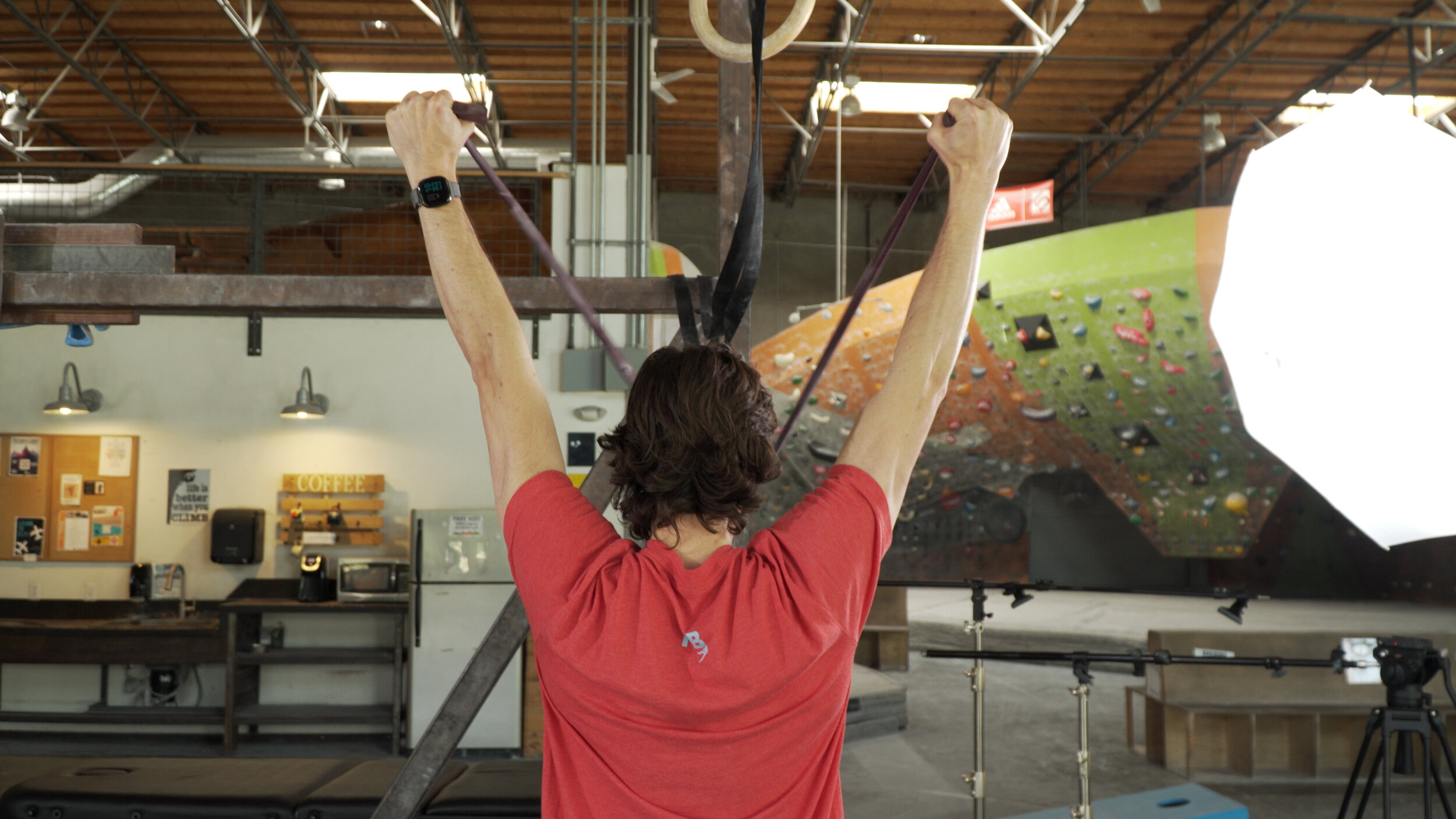
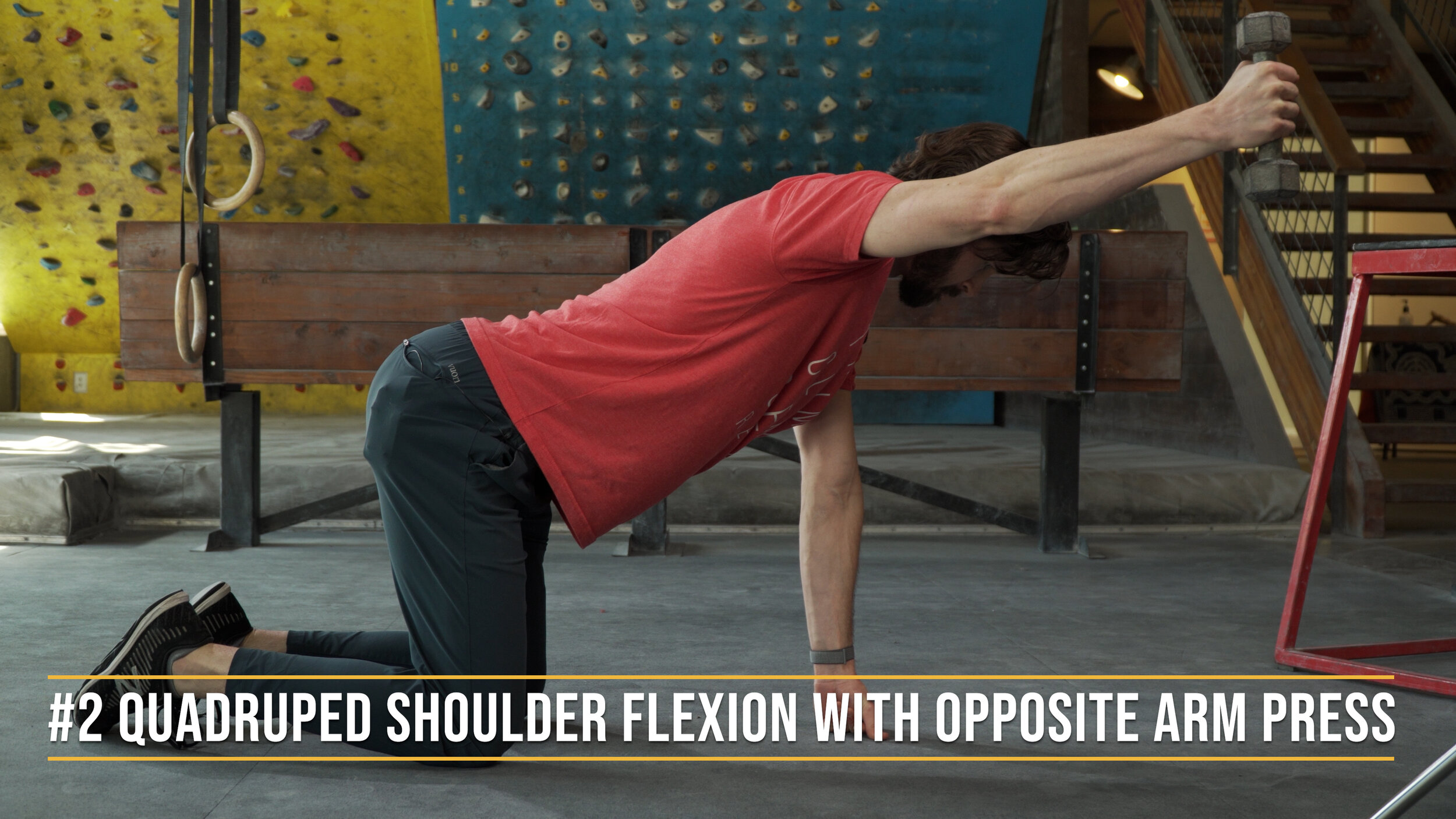
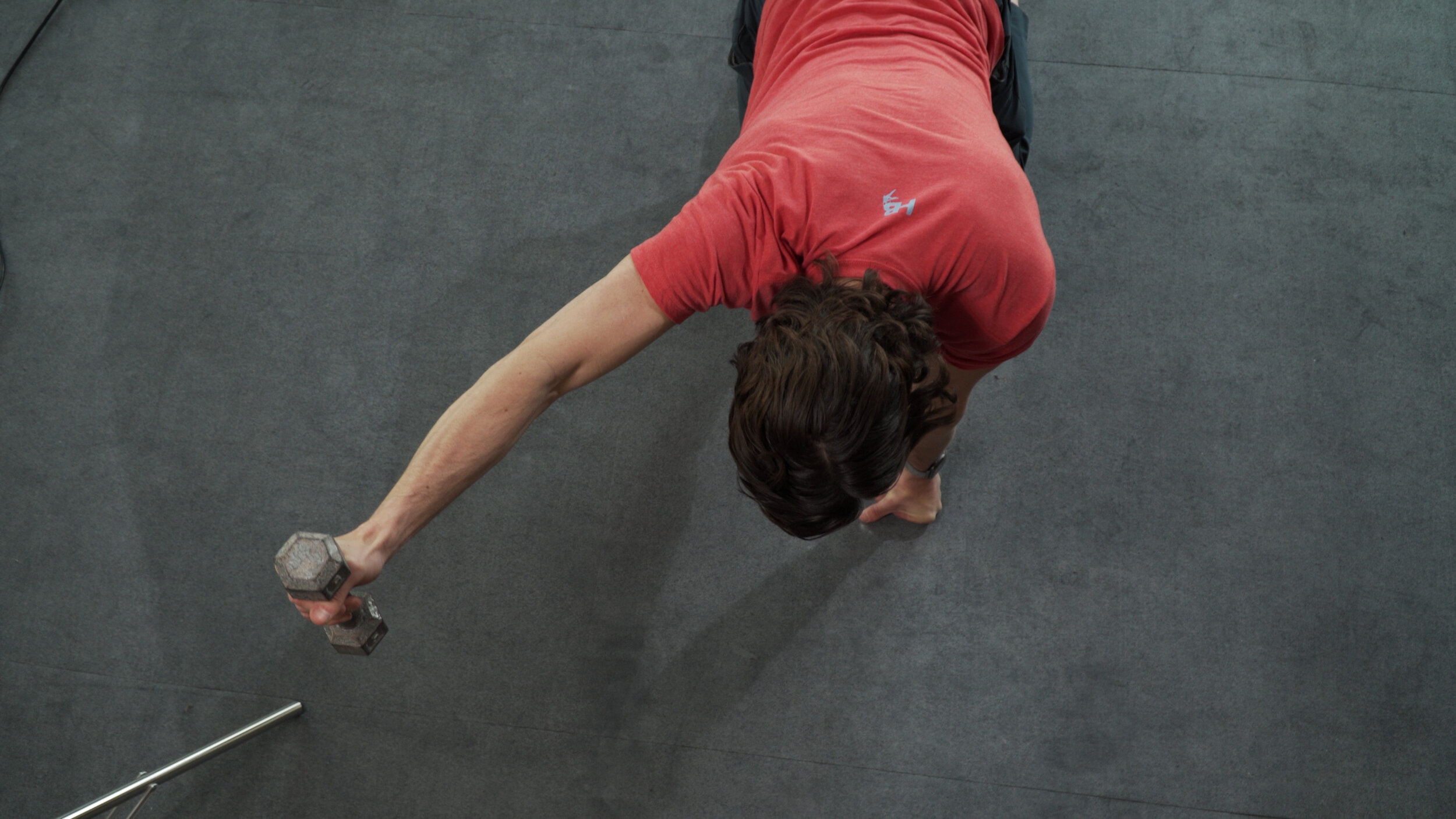
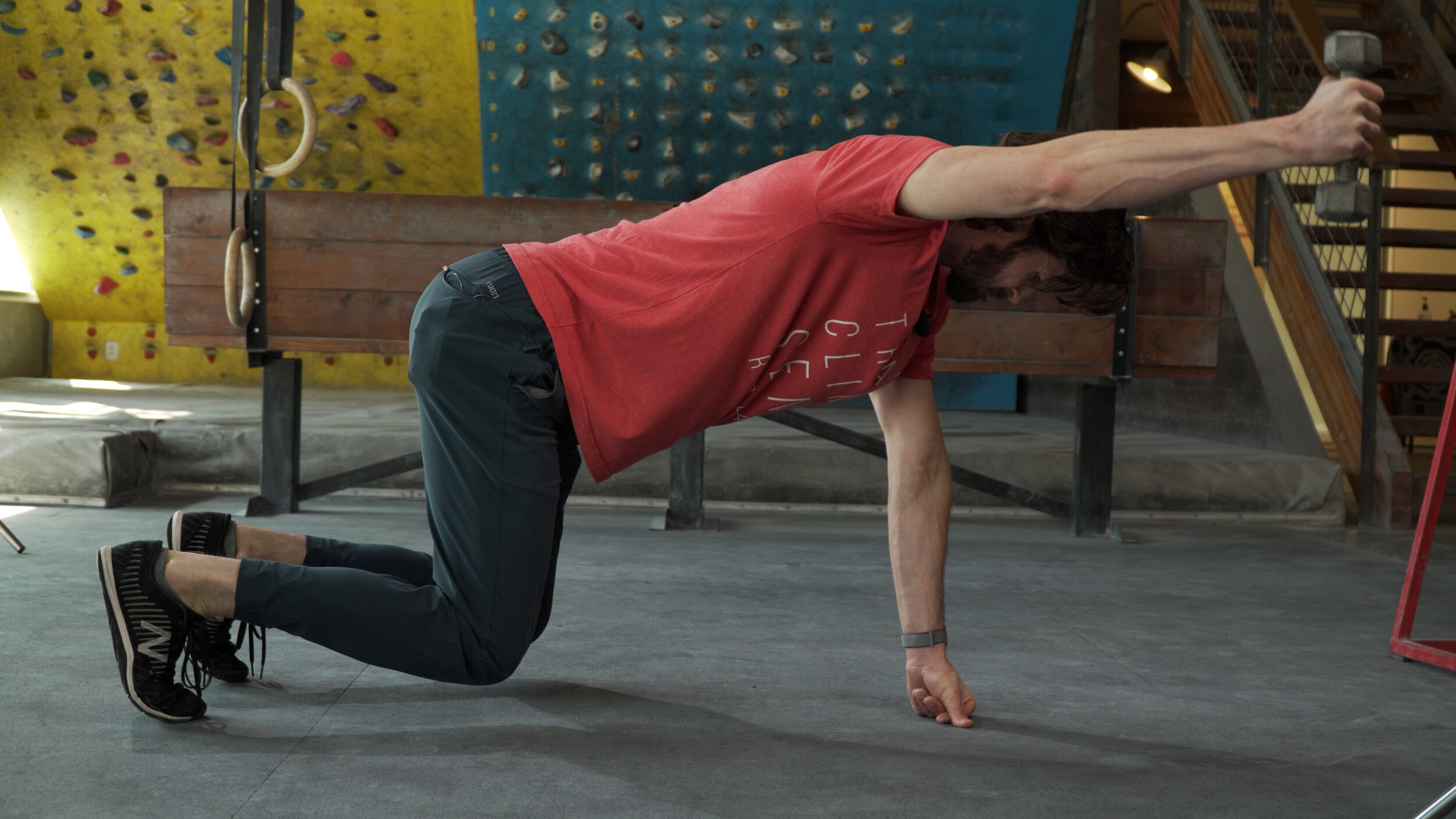
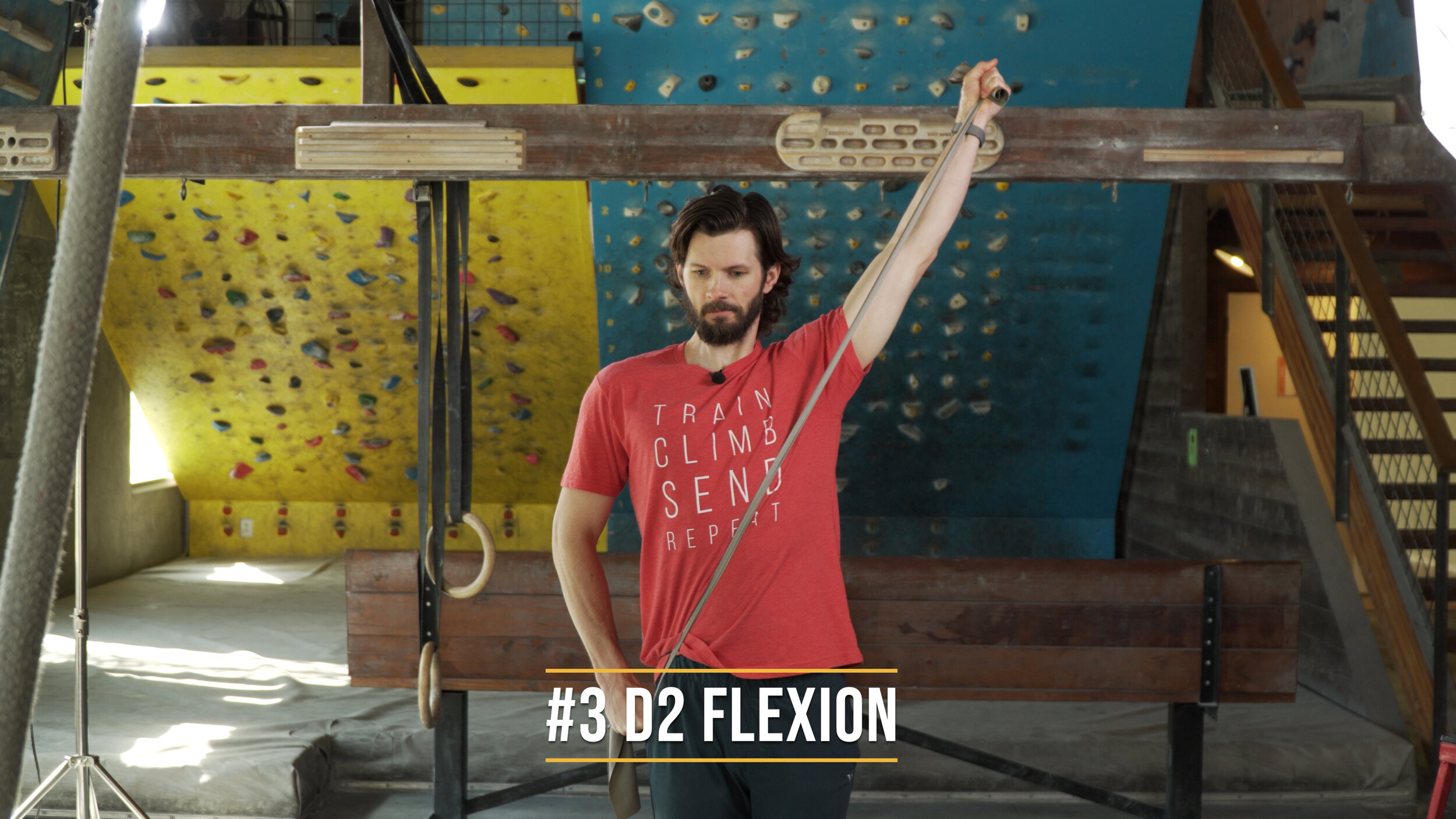
Face Pull with Overhead Press - This is just a mega exercise. Not only does it work the lower trap, but it also works the external rotators, AND it works them in the 90/90 position which is great for climbers. AND you have to go from 90 to ~140 degrees of abduction so it works the lower trap throughout a wide range of motion. BOOM! I highly recommend this exercise, BUT, I also recommend it isn’t your first exercise of the day. Make sure you are warmed up before you try this one out.
Quadruped Shoulder flexion with opposite arm press. - Another great exercise if you are specifically trying to work on improving your overhead strength/stability while triggering both the lower trap AND serratus anterior. This also has great EMG research done supporting it. This exercise can be done with little to no weight and you can definitely increase weight as you feel stronger. My only qualm with this is that it is not as functional as the other two I recommend.
Want a cool, super hard progression? Move the hand slightly closer to midline, and simply lift your knees off of the ground placing the weight in your toes. Make sure your core is engaged for this surprisingly hard challenge!
D2 Flexion - Finally, the classic, D2 flexion. A solid exercise that can be done on the go. You can do this as part of your warm up for climbing to help work on activation of the trapezius muscle in an overhead position at the gym or the crag. This exercise may help improve your motor control and awareness. Which is especially helpful in the overhead position. Sadly, this exercise is not as much for improving strength as much as it is for developing motor control. It is for that reason I still have it in my top 3.
ON THE WALL: RECOMMENDED EXERCISE
This climbing drill can be done on multiple levels of difficulty, but I recommend starting on jugs to make it easier. That way you can focus on the activation of the muscle and not just if you can hold the grip or not.
Step 1: isometric scapular retraction on the wall.
This is your easiest drill. Simply stabilize yourself on the wall with your arm overhead and out to the side (Y position). Allow yourself to hang back a little, then tighten the core, squeeze the glutes, and engage your shoulder blade down and back to engage the lower trap. This should all bring you nice and close to the wall.
Step 2: Step up and Hold
Next, place your foot in an appropriate position, and slowly step up and bring yourself to a 90/90 position or a lock off position while maintaining the scapular retraction. Hold here briefly, then either switch arms, or try step three.
Step 3: The downclimb
After completing step 2. See if you can slowly lower yourself back down with good control. You can then repeat steps 1 and 2, keep lowering down, or, attempt Step 4.
Step 4: the dynamic move.
Once you feel like you have everything locked and loaded. The form is great, the shoulder feels good, the core is active, make it dynamic.
Position yourself safely on good feet and holds. Pick your next target, move up quickly with a mild dead point technique, and BOOM, hit the hold and engage like you practice in step 1. If you fail, try again!
Now for the question I always get, how do I incorporate this into my training?
HOW TO INCORPORATE THIS INTO YOUR TRAINING (SETS, REPS, & FREQUENCY)
There are two main things to consider here: you may need to add this into your training day, BUT, you may also need to include it in your warm up ritual for climbing.
If incorporating it into your climbing day, it’s really simple. Start by performing D2 flexion, or any of the exercises I mentioned (In this case, I prefer the D2 flexion because it is more of a warm up / activation exercise). Then try the aforementioned drill as part of your warm up to climbing while you work on some easy problems!
When it comes to incorporating it into other routines, it depends on if you have a weight training day or not. If you have a weight training day, you can use the D2 flexion as a warm up OR incorporate the mega face pull with overhead press into one of your middle or later exercises. If you don’t do training days and just climb, you can include it at the end of your climbing, but watch for fatigue or compensations.
OUTRO
Hopefully you now have a better understanding of the importance of lower traps and how to train them. I know there are sooo many things you could be training, but if you have experienced shoulder or neck issues before, this may be well worth your time! And remember to keep an eye out for our other video with a bunch of other great lower trap exercises to keep things interesting.
Until next time…
Train those lower traps! Climb those mega reachy projects but with sensational shoulder control. Send it and try to kiss your lower trap to thank it. Repeat.
RESEARCH
Title
Surface electromyographic analysis of exercises for the trapezius and serratus anterior muscles
Citation
Ekstrom RA, Donatelli RA, Soderberg GL. Surface electromyographic analysis of exercises for the trapezius and serratus anterior muscles. J Orthop Sports Phys Ther. 2003 May;33(5):247-58. doi: 10.2519/jospt.2003.33.5.247. PMID: 12774999.
Key Take-aways
The optimal exercise for activating the lower trapezius was the arm raise overhead in line with the lower trapezius muscle fibers and with the subject in the prone position
An alternative exercise that produced high levels of EMG activity (79% MVIC) in the lower trapezius was prone shoulder external rotation at 90° of abduction
A third exercise that produced relatively high EMG activity (74% MVIC) in the lower trapezius was shoulder horizontal extension with external rotation
They identified shoulder abduction from 90° to 150° as the optimal exercise for activating the lower trapezius
Title
Anatomy and actions of the trapezius muscle
Citation
Johnson G, Bogduk N, Nowitzke A, House D. Anatomy and actions of the trapezius muscle. Clin Biomech (Bristol, Avon). 1994 Jan;9(1):44-50. doi: 10.1016/0268-0033(94)90057-4. PMID: 23916077.
Key Take-aways
As recognized by previous authors’-” the muscle clearly has three parts, but these parts have distinct and constant origins and insertions.
superior (nuchal) part arises from the superior nuchal line and the ligamenturn nuchae; it inserts into the lateral third of the clavicle.
The middle part consists of those fascicles from C, and Ti with the C, fascicle reaching the acromion and the Ti fascicle reaching the spine of the scapula
The lower part consists of those fascicles from spinous processes below Ti and whose insertions are concentrated on the deltoid tubercle of the scapula.
dictates that in the horizontal plane the action of the upper and middle trapezius is to draw the clavicle, acromion, and spine of the scapula backwards and medially
The pattern of attachments and orientation of the hbres of trapezius invites a consideration of their role in upward rotation of the scapula.
Consequently, their ability to generate an upward rotatory moment is compromised by relatively short moment arms. However, their efficiency would be increased once upward rotation has been initiated (ostensibly by the serratus anterior);
Some published descriptions imply that the trapezius alone can rotate the scapula, its upper fibres pulling upwards and its lower fibres pulling downwards to create a force-couple I,15 . Other descriptions convey this same implication but add that trapezius acts in conjunction with serratus anterior2V4.7-9*‘6”7. These descriptions are incorrect for the following reason. Trapezius alone cannot exert a force couple on the scapula because its upper and lower fibres do not act in opposite directions so as to produce zero net force. Another muscle is required, and must act in an opposite direction. Serratus anterior is such a muscle.
. Their transverse orientation is well suited to draw the clavicle and scapula backwards in actions such as pulling and rowing, but denies any capacity of these fibres to pull the clavicle and scapula upwards
Title
A new manual muscle test for assessing the entire trapezius muscle
Citation
Cibulka MT, Weissenborn D, Donham M, Rammacher H, Cuppy P, Ross SA. A new manual muscle test for assessing the entire trapezius muscle. Physiother Theory Pract. 2013 Apr;29(3):242-8. doi: 10.3109/09593985.2012.718856. Epub 2012 Sep 7. PMID: 22957845.
Key Take-aways
The new trapezius muscle test position was performed while standing. First, a 12-inch standard plastic goniometer was used to establish the shoulder abduction angle of 110° for the new trapezius muscle test position. A test position of 110° abduction was selected because this position is the approximate mid-position of what is usually considered the range where most of the scapula rotation occurs during the shoulder abduction (80° and 140°) (Bagg and Forrest, 1986, 1988). The randomly selected arm was placed at 110° of abduction with their palms facing toward the ground, which places the upper extremity in abduction and internal rotation. The examiner then applied pressure against the mid-forearm, while also with the other hand holding and applying a medial directed force on the inferior angle of the scapula. Scapular downward rotation, monitored by any medial movement of the inferior scapular angle, would suggest that the trapezius muscle was not holding its upwardly rotated position (suggesting muscle weakness). The subject was asked to try and maintain the set joint position against the applied pressure by the examiner for 5 s
Title
Electromyographic activity of scapular muscles during diagonal patterns using elastic resistance and free weights
Citation
Witt D, Talbott N, Kotowski S. Electromyographic activity of scapular muscles during diagonal patterns using elastic resistance and free weights. Int J Sports Phys Ther. 2011 Dec;6(4):322-32. PMID: 22163094; PMCID: PMC3230160.
Key Take-aways
The upper extremity PNF pattern did significantly affect the mean UT, MT and LT activity but was not found to significantly affect SA activity. The type of resistance did not significantly change muscle activity when used in the same diagonal patterns.
Disclaimer:
As always, exercises are to be performed assuming your own risk and should not be done if you feel you are at risk for injury. See a medical professional if you have concerns before starting new exercises.
Written and Produced by Jason Hooper (PT, DPT, OCS, SCS, CAFS) and Emile Modesitt
IG: @hoopersbetaofficial
